Logitech has
long since carved out a tidy niche in peripherals ranging from PC
gadgets and interfaces to console game controllers and steering wheels.
And, overwhelmingly, Logitech does a good job when they put their mind
to it. There is always the possibility of an idea a bit ahead of its
time (like the early wireless mice), but when Logitech hones a
technology you can bet it is being honed in the best possible way. So it
is no surprise that the MX series of optical mice are, on the whole,
very, very good. Three models make up the MX series – the 300, 500, and
700. As you’d expect, each model offers a bit more, and the MX 700 mouse
is a pinnacle of mousing technology that will make your friends jealous
and your fingers happy.
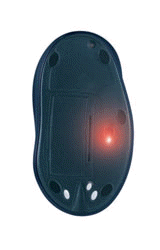 All
of the MX series mice feature next generation optical technology from
Logitech. This allows much more precise movement on a wider variety of
surfaces. In the past, optical mice have often hiccupped when used on
surfaces such as wood-grain desktops. The problem is that the variance
in the pattern of the surface can cause interference with the laser
reflection and detection – optical mice work by recognizing the laser as
it is reflected from the mousing surface back into the mouse. Logitech
has beefed up this technology to allow more precision and better
reliability on a variety of surfaces, and that is perhaps the most
evident improvement in all three models. My old optical mouse would
regularly jump from one side of the screen to the other as I moved it
across my wood-grain desktop. That behavior instantly, and noticeably,
disappeared when I plugged in the MX series mice.
All
of the MX series mice feature next generation optical technology from
Logitech. This allows much more precise movement on a wider variety of
surfaces. In the past, optical mice have often hiccupped when used on
surfaces such as wood-grain desktops. The problem is that the variance
in the pattern of the surface can cause interference with the laser
reflection and detection – optical mice work by recognizing the laser as
it is reflected from the mousing surface back into the mouse. Logitech
has beefed up this technology to allow more precision and better
reliability on a variety of surfaces, and that is perhaps the most
evident improvement in all three models. My old optical mouse would
regularly jump from one side of the screen to the other as I moved it
across my wood-grain desktop. That behavior instantly, and noticeably,
disappeared when I plugged in the MX series mice.
The MX series mice also feature a wide variety of platform and
connection compatibility. They will work on both Mac and PC platforms,
allowing users of both types to enjoy the enhanced productivity and
general comfort of these robust mice. They also support both USB and PS2
connections, meaning that these mice can be added to older systems,
systems overloaded on USB peripherals, and the latest USB-laden
computers. Supporting such a wide variety of platforms and connections
means that just about anyone can pick up one of these mice and get it
running in a matter of minutes. Logitech maintains its habit of
providing good installation instructions and programs, so we have to
give the MX series mice a strong rating on ease of setup.
MX 300 (MSRP $29.95)
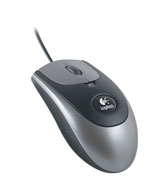 The MX
300 is a basic, bare-bones model that doesn’t skimp on usability or
functionality. It features the standard two-button and scroll wheel
setup, plus it includes an additional "quick-switch" button to allow you
to jump between programs easily. This mouse is a solid performer with a
fairly common look and feel to it. The most innovative function is the
"quick-switch", which works a lot like using the alt-tab combination to
scroll through open applications. Of course, the MX 300 sports the same
next-generation optical mouse technology of the other two models, which
is welcome. Overall, the MX 300 is a great choice for those on a budget.
I cannot stress enough how much the scroll wheel and optical eye change
your relationship with your mouse, and once you’ve experienced these
features, you’ll never go back to your old mouse. So if you’ve been
holding out on upgrading your mouse, this is a perfect time to get into
the most essential of the new features at a price that is more than
reasonable.
The MX
300 is a basic, bare-bones model that doesn’t skimp on usability or
functionality. It features the standard two-button and scroll wheel
setup, plus it includes an additional "quick-switch" button to allow you
to jump between programs easily. This mouse is a solid performer with a
fairly common look and feel to it. The most innovative function is the
"quick-switch", which works a lot like using the alt-tab combination to
scroll through open applications. Of course, the MX 300 sports the same
next-generation optical mouse technology of the other two models, which
is welcome. Overall, the MX 300 is a great choice for those on a budget.
I cannot stress enough how much the scroll wheel and optical eye change
your relationship with your mouse, and once you’ve experienced these
features, you’ll never go back to your old mouse. So if you’ve been
holding out on upgrading your mouse, this is a perfect time to get into
the most essential of the new features at a price that is more than
reasonable.
MX 500 (MSRP $49.95)
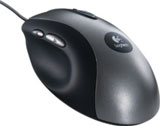 The MX
500 kicks it up a notch. It is an optical mouse featuring the standard
two buttons and scroll wheel, the quick-switch button, and the latest
optical technology. The additional features of the MX 500 are the
"cruise control" buttons (two of them) and the addition of two thumb
buttons. By default these thumb buttons are configured to work as
"forward" and "backward" in your browser (or any application that
features forward and backward buttons), but can be customized to perform
almost any keystroke. Those of you who have made the leap to the scroll
wheel already should understand the potential of having two more buttons
at your disposal. The thumb navigation buttons rapidly become required,
and making the transition from your coveted eight-button mouse to
anything less quickly becomes a sad experience. The cruise control
buttons are similarly useful – they allow you to scroll up and down in a
document without rolling the scroll wheel – but have not gained as
coveted a spot in my heart as the forward and back thumb buttons.
The MX
500 kicks it up a notch. It is an optical mouse featuring the standard
two buttons and scroll wheel, the quick-switch button, and the latest
optical technology. The additional features of the MX 500 are the
"cruise control" buttons (two of them) and the addition of two thumb
buttons. By default these thumb buttons are configured to work as
"forward" and "backward" in your browser (or any application that
features forward and backward buttons), but can be customized to perform
almost any keystroke. Those of you who have made the leap to the scroll
wheel already should understand the potential of having two more buttons
at your disposal. The thumb navigation buttons rapidly become required,
and making the transition from your coveted eight-button mouse to
anything less quickly becomes a sad experience. The cruise control
buttons are similarly useful – they allow you to scroll up and down in a
document without rolling the scroll wheel – but have not gained as
coveted a spot in my heart as the forward and back thumb buttons.
 Also
worth mentioning is the really stylish design of the MX 500 mouse. If
you have one of the new charcoal-and-black PC cases, this baby fits
right in. It looks perfect. While the MX 300 adheres to the common mouse
design of the 1990s, the MX 500 looks like something out of a sci-fi
movie. The design is ergonomic, comfortable, and snazzy. The thumb
cradle is just right, and textured slightly to be very comfortable, and
the thumb buttons are positioned perfectly for optimal use. The right
and left mouse buttons are stylishly set off in a flecked charcoal and
their hingeless design makes the mouse much more aesthetically pleasing.
The cruise control buttons are slightly awkward at first, but remain
usable. Overall, the MX 500 not only packs a ton of functionality, but
it looks really cool.
Also
worth mentioning is the really stylish design of the MX 500 mouse. If
you have one of the new charcoal-and-black PC cases, this baby fits
right in. It looks perfect. While the MX 300 adheres to the common mouse
design of the 1990s, the MX 500 looks like something out of a sci-fi
movie. The design is ergonomic, comfortable, and snazzy. The thumb
cradle is just right, and textured slightly to be very comfortable, and
the thumb buttons are positioned perfectly for optimal use. The right
and left mouse buttons are stylishly set off in a flecked charcoal and
their hingeless design makes the mouse much more aesthetically pleasing.
The cruise control buttons are slightly awkward at first, but remain
usable. Overall, the MX 500 not only packs a ton of functionality, but
it looks really cool.
MX 700 (MSRP $79.95)
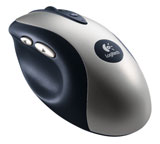 Anyone
willing to spend $80 on a mouse is a serious computer user, and it’s
good to see Logitech reward that dedication to the machine with a high
quality product. The MX 700 is a wonderful wireless mouse with all the
functionality of the MX 500. The MX 700 features the same eight button
configuration, the same great design, but it frees all of this from the
constraints of the cord, and for anyone sick of fighting a mess of
peripheral wires on the desktop, this is a welcome improvement.
Furthermore, Logitech has improved upon this improvement, making the
wireless technology more robust, reliable, and easy.
Anyone
willing to spend $80 on a mouse is a serious computer user, and it’s
good to see Logitech reward that dedication to the machine with a high
quality product. The MX 700 is a wonderful wireless mouse with all the
functionality of the MX 500. The MX 700 features the same eight button
configuration, the same great design, but it frees all of this from the
constraints of the cord, and for anyone sick of fighting a mess of
peripheral wires on the desktop, this is a welcome improvement.
Furthermore, Logitech has improved upon this improvement, making the
wireless technology more robust, reliable, and easy.
The wireless MX 700 works on RF (radio frequency) technology to give
you wireless freedom without the need for line-of-sight, as required for
things like TV remotes. The MX 700 uses a combination receiver/recharger
base to communicate with the computer. You plug the base in to the wall
and your computer, set it on your desktop, and your mouse will operate
anywhere within six feet of the unit.
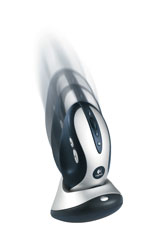 The
problem with wireless mice is that they require a battery, and that
battery gets a lot of use because the mouse must always be in
communication with the PC in order to provide the precise and
instantaneous reactions we demand from our input devices. Previous
versions of wireless mice have had notorious power consumption issues,
requiring you to keep a battery charger and a backup battery on hand for
when your mouse crapped out on you at the most inopportune moment. The
MX 700 works around this issue by including a rechargeable battery in
the mouse that can be charged by placing the mouse in the receiver/recharger
base. After extensive testing, I’ve only been able to get my mouse to
"die" once – I left it out of the charger and used it significantly for
several days. Upon discovering the mouse had actually run out of battery
charge, I placed it back in the unit. Not five minutes later, I picked
up the mouse and used it to finish my work and shut down my machine.
Even with a partial charge the mouse performed wonderfully.
The
problem with wireless mice is that they require a battery, and that
battery gets a lot of use because the mouse must always be in
communication with the PC in order to provide the precise and
instantaneous reactions we demand from our input devices. Previous
versions of wireless mice have had notorious power consumption issues,
requiring you to keep a battery charger and a backup battery on hand for
when your mouse crapped out on you at the most inopportune moment. The
MX 700 works around this issue by including a rechargeable battery in
the mouse that can be charged by placing the mouse in the receiver/recharger
base. After extensive testing, I’ve only been able to get my mouse to
"die" once – I left it out of the charger and used it significantly for
several days. Upon discovering the mouse had actually run out of battery
charge, I placed it back in the unit. Not five minutes later, I picked
up the mouse and used it to finish my work and shut down my machine.
Even with a partial charge the mouse performed wonderfully.
It takes only about two hours to fully charge the battery, which, as
I stated above, lasts for a remarkably long time. There is a handy light
on the mouse that indicates how much battery charge remains or how
complete the recharging process is. In general, this is the most
worry-free cordless mouse I’ve come in contact with.
And that same positive sentiment goes for the entire MX series. The
biggest problem we had with them was an extremely rare compatibility
issue with some of the extra functions. In the vast majority of
applications, and certainly all of the most common applications, the
mice performed with no problem. However, the MX 500 and 700 had problems
mapping alternate functions to some of the buttons in games like Unreal
Tournament 2003 and No One Lives Forever 2. One of the bonuses in having
a scroll wheel when playing a first person shooter is that you can
usually use it to scroll through your weapons. I found it extremely
disappointing to find that UT2003 and NOLF2 didn’t support the MX series
mice to provide this function. There are workarounds (the easiest is to
just re-map the thumb buttons to "control" and "shift" and then
configure the game to use "control" and "shift" to cycle through your
weapons), and thanks to the robust configuration utility you can
generally get the results you want. This will be less of a problem as
new games are created in an environment that takes into account the MX
series mice. Innovation is a double-edged sword.
Aside from that minor issue, we have nothing but love for our new MX
series mice. The eight button configuration, comfortable design, snazzy
aesthetic, and solid functioning make them highly desirable. I stand by
my conviction that once you’ve experienced the sublime beauty of an
eight button mouse, you will not want to go back, and I firmly believe
that wires are "so" 20th Century. Some folks may doubt
spending $80 on a mouse is worth it, but I say you can pry my obscenely
overdeveloped mouse out of my cold, dead hands.
